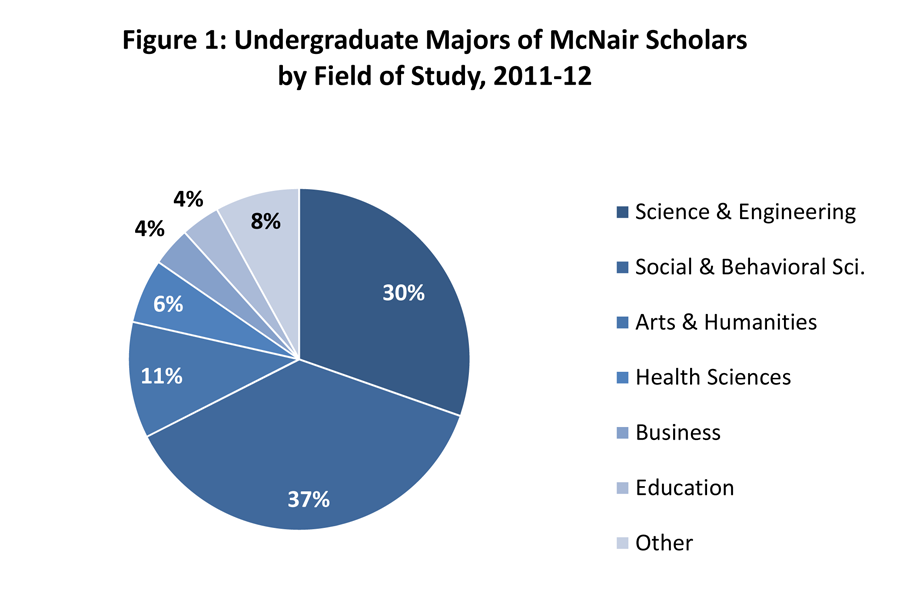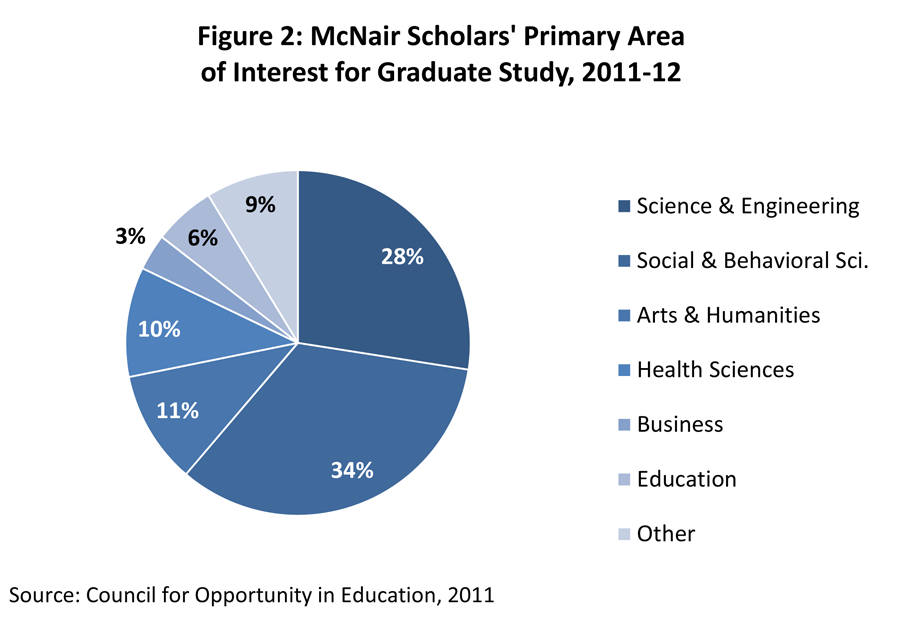You are on CGS' Legacy Site.
Thank you for visiting CGS! You are currently using CGS' legacy site, which is no longer supported. For up-to-date information, including publications purchasing and meeting information, please visit cgsnet.org.
(Reprinted from the April 2012 issue of GradEdge)
The Ronald E. McNair Post-Baccalaureate Achievement Program, also known as the McNair Scholars Program, is the largest federal effort aimed at preparing low-income, first-generation in college and minority undergraduates to pursue doctoral studies. The McNair Scholars Program is funded through the U.S. Department of Education’s TRIO programs and provides participants with research internships, faculty mentors, opportunities to present and publish results of their research, undergraduate teaching experience, and assistance with applying to and preparing for graduate school.
McNair Scholars represent a diverse pool of prospective graduate students, including students who are traditionally underrepresented at all levels of higher education. According to the U.S. Department of Education, about seven out of ten McNair Scholars (71%) are low-income and first-generation college students (U.S. Department of Education, 2007). In addition, seven out of ten McNair Scholars are underrepresented minorities. In 2004–05, the latest year for which data are available, about 43% of McNair Scholars were Black/African American, about 24% were Hispanic/Latino, and approximately 3% were American Indian/Alaska Native. That same year, more than two-thirds (68%) of all McNair Scholars were female, a percentage that has gradually increased over time, up from about 65% in 1997–98 (U.S. Department of Education, 2005; U.S. Department of Education, 2007).
While the Department of Education has reported on the demographic characteristics of McNair Scholars, to date the Department has not released any data on McNair Scholars by field of study. However, this information can be gleaned from the annual McNair Scholars Directory. Conducted under the auspices of the CGS/COE Joint McNair Committee, the McNair Scholars Directory is a collaborative effort of the Council of Graduate Schools and the Council for Opportunity in Education. The directory is designed to provide graduate schools with access to McNair Scholars who have expressed an interest in pursuing graduate studies in order to facilitate the recruitment of these highly talented individuals into graduate school. The directory contains records of recent graduates, seniors, and rising seniors, with McNair Scholars’ names, contact information, undergraduate majors, areas of interest for graduate study, and undergraduate research projects. More than four out of five (84%) McNair Scholars Programs provided information for the 2011–12 McNair Scholars directory; roughly 3,300 McNair Scholars are included in the Directory. (The password-protected Directory is available for download from COE’s website, http://www.coenet.us.)
Among the McNair Scholars included in the 2011–12 McNair Scholars Directory, two-thirds are enrolled in science, technology, engineering, and mathematics (STEM) fields at the undergraduate level (Council for Opportunity in Education, 2011). As shown in Figure 1, 30% are enrolled in science and engineering fields, and 37% are in social and behavioral sciences at the undergraduate level. About one in ten McNair Scholars are pursuing a degree in arts and humanities.

The enrollment of McNair Scholars by field of study differs substantially from overall undergraduate enrollment. While two-thirds of McNair Scholars are in STEM fields, only about three out of ten undergraduates at four-year institutions in the United States are majoring in STEM fields (including social sciences), indicating that McNair Scholars are more than twice as likely than all undergraduates to be pursuing a degree in STEM (Snyder & Dillow, 2011).
As shown in Figure 2, similar but slightly smaller percentages of the McNair Scholars included in the 2011–12 McNair Scholars Directory indicated that their primary area of interest for graduate study was in STEM (Council for Opportunity in Education, 2011). Some 28% of McNair Scholars intend to enroll in science and engineering at the graduate level, and one-third (34%) plan to pursue a graduate degree in social and behavioral sciences. Arts and humanities and health sciences each account for about one out of ten McNair Scholars.

While the data on outcomes for McNair Scholars are incomplete, the available data do indicate that the bachelor’s degree attainment rate of McNair Scholars is very high. Among active McNair Scholars in 1997–98, 95% of these students completed their bachelor’s degree by 2001–02 (U.S. Department of Education, 2005). Overall at the bachelor’s level, only about 57% of all first-time, full-time students at four-year institutions complete a bachelor’s degree within six years (Knapp, Kelly-Reid, & Ginder, 2011). While there is not a direct comparison between these two statistics, it does illustrate the high success rate of McNair Scholars in completing their undergraduate degrees.
The available data also suggest that McNair Scholars have high graduate enrollment rates. Among McNair Scholars who graduated in 2006–07, more than one-half (53%) were enrolled in graduate school in 2007–08, the academic year immediately after receipt of the baccalaureate (U.S. Department of Education, 2012). The outcomes data from earlier cohorts suggest that even more of the 2006–07 McNair Scholars enrolled in graduate school two or more years after receipt of the baccalaureate (U.S. Department of Education, 2005). There is also some evidence to suggest that McNair Scholars are more likely to enroll in graduate school in the year after graduation than their demographically similar non-McNair peers. However, this analysis is limited by some missing and invalid data, and in some cases from inconsistencies in the way that questions were asked from year to year (U.S. Department of Education, 2005).
Discussion
Overall, McNair Scholars are more likely to be from populations that are underrepresented in graduate education and are likely to be majoring in STEM fields. Additionally, McNair Scholars are receiving the preparation to enable them to succeed at the graduate level, making this population of talented students an important focus for graduate school recruitment. As stated in the 2010 report, The Path Forward, the global competitiveness of the United States and our capacity for innovation hinge fundamentally on our ability to produce sufficient numbers of graduate degree-holders to meet future workforce demands, and key to accomplishing this is increasing the numbers of underrepresented students entering, and completing, graduate studies (Wendler et al., 2010). The goal of the McNair Scholars program is to do just that.
Despite having some data about the characteristics of McNair Scholars, their undergraduate degree attainment rates, and their immediate graduate school enrollment rates, an examination of outcomes for McNair Scholars is constrained by a lack of sufficient data. We know nothing about the outcomes for McNair Scholars who completed their undergraduate degrees within the past five years, even though this information is reported annually by the McNair Scholars Programs to the U.S. Department of Education. For the earlier cohorts, we lack sufficient data to reveal the eventual doctoral degree attainment rates for McNair Scholars, as well as other types of advanced degrees they may have earned, such as master’s degrees and first-professional degrees. These data, along with information on career outcomes, would provide a much more comprehensive picture of the impact of the McNair Scholars Program. A more robust, longer term study, including a study of a comparison group of low income, first generation undergraduates who did not participate in the McNair Scholars Program, would reveal more complete information about outcomes for McNair Scholars.
By Nathan E. Bell, Director, Research and Policy Analysis, Council of Graduate Schools
References:
Council for Opportunity in Education. (2011). 2011–2012 McNair Scholars Directory. Retrieved from http://www.coenet.us.
Knapp, L.G., Kelly-Reid, J.E., and Ginder, S.A. (2011). Enrollment in Postsecondary Institutions, Fall 2009; Graduation Rates, 2003 & 2006 Cohorts; and Financial Statistics, Fiscal Year 2009 (NCES 2011-230). Washington, DC: U.S. Department of Education.
Snyder, T.D., and Dillow, S.A. (2011). Digest of Education Statistics 2010. Washington, DC: U.S. Department of Education.
U.S. Department of Education. (2005). A Profile of the Ronald E. McNair Postbaccalaureate Achievement Program: 1997–1998 Through 2001–2002. Washington, DC: Author.
U.S. Department of Education. (2007). Ronald E. McNair Postbaccalaureate Achievement Program: 2002–05 Facts and Figures at a Glance. Washington, DC: Author.
U.S. Department of Education. (2012). Ronald E. McNair Postbaccalaureate Achievement Program Annual Performance Reports, 2006–07 and 2007–08. Retrieved from http://www2.ed.gov/programs/triomcnair/mcnair-cy-0607.pdf
Wendler, C., Bridgeman, B., Cline, F., Millett, C., Rock, J., Bell, N., and McAllister, P. (2010). The Path Forward: The Future of Graduate Education in the United States. Princeton, NJ: Educational Testing Service.




